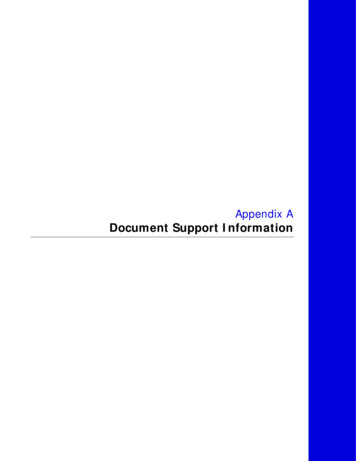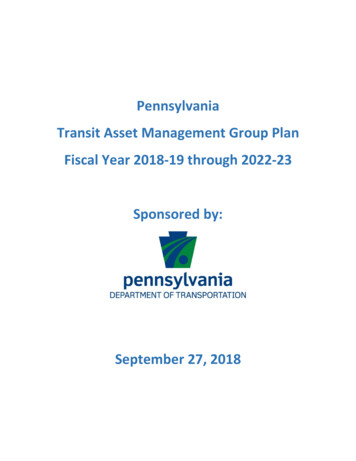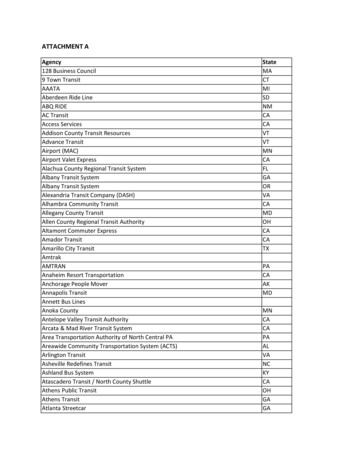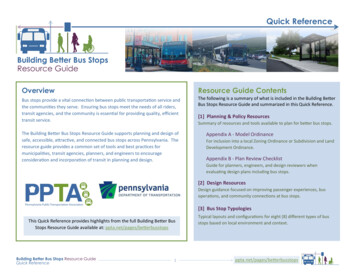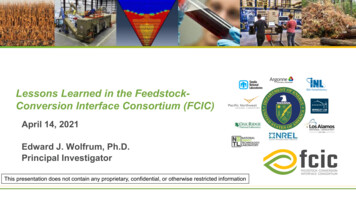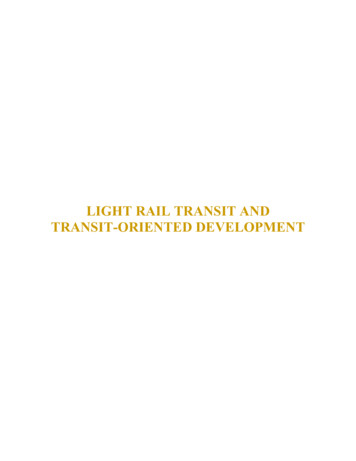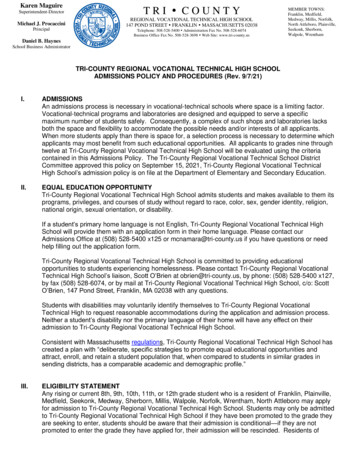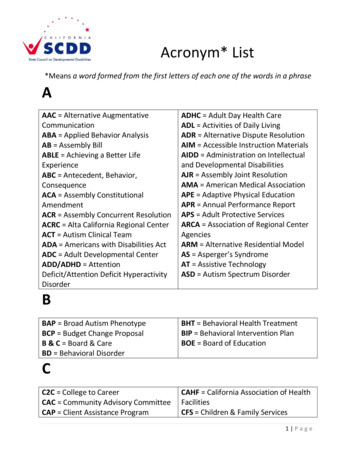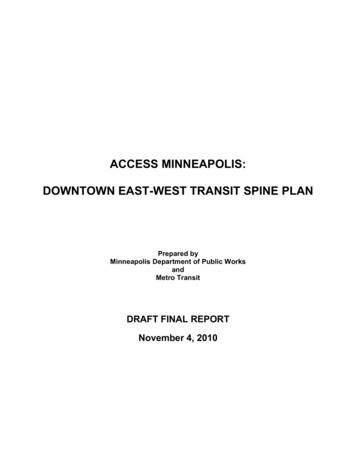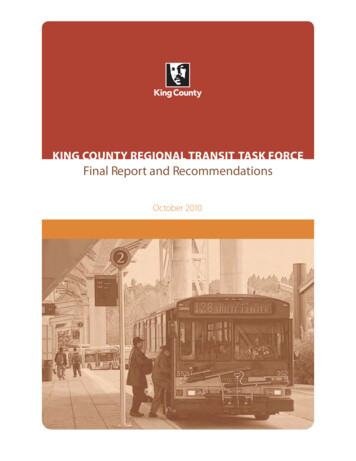
Transcription
KING COUNTY REGIONAL TRANSIT TASK FORCEFinal Report and RecommendationsOctober 2010
FOR INFORMATION, CONTACT:Victor Obeso, Manager, Service DevelopmentMetro Transit DivisionDepartment of TransportationKSC-TR-0422201 S. Jackson Street, Seattle, WA 98104-3856(206) TTF2010/dot/comm/sd/jpAlternative Formats Available206-263-5277 TTY Relay: 711
November 5, 2010Dow Constantine, King County ExecutiveKing County Chinook Building401 5th Ave., Suite 800Seattle, WA 98104King County Council Members516 Third Ave., Rm. 1200Seattle, WA 98104Dear Executive Constantine and Council Members:With this letter we are transmitting to you the final report of the Regional Transit Task Force.The issues you asked us to consider regarding the future of transit service in King County arevital to the growth of our respective communities and the quality of life for county residents.We have worked hard for seven months to craft these recommendations. We represent manydiverse perspectives, but through our discussions we developed agreement on a policyframework that we believe is in the best interests of all King County residents. When we beganthis process we set a high bar for ourselves – to attempt to reach unanimous consensus on ourrecommendations. We are pleased that the following report indeed reflects the unanimousapproval of the Task Force.We would be happy to serve as a resource in any way we can as you consider theserecommendations. We look forward to your review and hope that you and Metro will be able toestablish an aggressive schedule for the adoption and implementation of these recommendations.We would like to request that you convene the Task Force in mid-2011, after Council action onMetro’s Comprehensive and Strategic Plans, to provide us with an update on the follow-up tothis work.Thank you for the opportunity to serve on the task force. It has been challenging, but veryrewarding. We also thank Metro staff for their responsiveness and support of our effortsthroughout the process.Sincerely,Regional Transit Task Force Members(signatures on reverse)
Regional Transit Task Force Members: Chuck AyersCarl JacksonTom RasmussenShiv BatraRob JohnsonCarla SaulterFred ButlerKate JoncasJared SmithSuzette CookeJosh KavanaghJim StantonGrant DeggingerJane KuechleBob SwarnerBob DrewelSteve MarshallLarry YokChris EggenEd MillerLiz WarmanNon-VotingEx Officio Members:David FreibothLynn MoodyGene BaxstromNoel GerkenEstela OrtegaChris HoffmannTom PiersonKevin DesmondGreg Walker
Regional Transit Task Force MembersNameOrganizationRepresentation CategoryChuck AyersCascade Bicycle ClubRegional Interests –EnvironmentalShiv BatraRiders – EastGene Baxstrom*Joint Transportation CommitteeEx OfficioFred ButlerCouncilmember - IssaquahElected Officials – EastSuzette CookeMayor - KentElected Officials – SouthGrant DeggingerCouncilmember - BellevueElected Officials – EastKevin Desmond*King County Metro TransitEx OfficioBob DrewelPSRCRegional Interests – PSRCChris EggenCouncilmember - ShorelineElected Officials – WestDavid FreibothLabor CouncilOrganized LaborNoel GerkenMayor - Maple ValleyElected Officials – SouthChristine HoffmannRedmond ChamberEconomic Development –EastCarl JacksonAmalgamated Transit UnionOrganized LaborRob JohnsonTransportation ChoicesRegional Interests –EnvironmentalKate JoncasDowntown Seattle AssocEconomic Development –WestJosh KavanaghUniversity of WashingtonEducation – WestJane KuechleAtWork!Regional Interests –Accessible ServicesSteve MarshallCascadia CenterTransportation ExpertEd MillerLynn MoodyTransit Advisory CommitteeHopelinkSocial Services – EastEstela OrtegaEl Centro De La RazaSocial Services – WestTom PiersonFederal Way ChamberEconomic Development –SouthTom RasmussenCouncilmember - SeattleElected Officials – WestCarla SaulterRiders – WestJared SmithParsons BrinckerhoffTransportation ExpertJim StantonMicrosoftTrip Reduction – EastBob SwarnerRiders – SouthRon Tober* (starting in Sept.replaced by Greg Walker)Sound TransitEx OfficioLiz WarmanBoeingTrip Reduction – SouthLarry YokHighline Community CollegeEducation – South* Ex-Officio MemberFacilitator: John Howell, Cedar River Group, LLCOctober 2010Regional Transit Task Force Final Report and Recommendationsi
Regional Transit Task 34567891011121314Larry YokEstela OrtegaEd MillerLynn MoodySuzette CookeRon ToberJared SmithJane KuechleShiv BatraGene BaxstromTom PiersonChris EggenNoel GerkenJosh Kavanagh1516171819202122232425Grant DeggingerRob JohnsonCarl JacksonDavid FreibothFred ButlerSteve MarshallBob DrewelChristine HoffmannJim StantonCarla SaulterTom RasmussenNot pictured: Chuck Ayers,Kevin Desmond, Kate Joncas,Bob Swarner, and Liz WarmanRegional Transit Task Force Final Report and RecommendationsOctober 2010
ContentsExecutive Summary 1Section 1: Introduction 7Charge to the Task Force 7Task Force Work Plan 8Section 2: Task Force Process 9Structure and Roles 9Meeting Schedule and Topics 9Consensus Approach and Ground Rules 10Public Information and Comment 11Statements of Policy Direction 11Section 3: Background Information 11Overview of Metro Services and Budget 11Challenges Facing Metro and Other Transit Agencies 15Regional Growth Forecast 16Section 4: Task Force Recommendations 17Introduction 17Performance Measures 19Cost Control and Efficiency 22Overall Policy Guidance for Service Reduction and Service Growth 24Implementation of Policy Direction: Use of Guidelines and Performance Measures 25Legislative Agenda to Address Future Service Needs 28Mission and Vision 30Section 5: Conclusion 31References 32Appendices 33Abbreviations and Glossary 33Enabling Legislation 38Task Force Ground Rules 41Metropolitan Transit Agency Comparisons on Productivity Measures 43Draft Sources and Uses of Funds 49Draft Performance Measures 52Status Report on Implementation of Audit Recommendations 55Conceptual Service Allocation Guidelines 65List of FiguresFigure 1. Ridership of Central Puget Sound Transit Agencies (2009) 13Figure 2. King County Metro’s Operating Revenue Sources 14Figure 3. King County Metro’s Operating Expenses 14Figure 4. Metro’s Projected Sales Tax Revenue Shortfall 15Figure 6. Service Families and Productivity Measures 20Figure 5. Overall Approach 26October 2010Regional Transit Task Force Final Report and Recommendationsiii
This page intentionally left blank.ivRegional Transit Task Force Final Report and RecommendationsOctober 2010
Executive SummaryBackgroundTask Force Charge and ProcessThe King County Council and Executive formed the Regional Transit Task Force in February 2010to consider a policy framework for the potential future growth and, if necessary, contraction of KingCounty’s transit system. The County Council asked the task force to consider six transit system designfactors, to which the task force added a seventh: environmental sustainability (see box).Key Transit SystemDesign Factors1. Land use2. Social equity andenvironmental justice3. Financial sustainability4. Geographic equity5. Economic development6. Productivitiy and efficiency7. Environmental sustainabilityThe 28 task force members were selected to represent abroad diversity of interests and perspectives. Three ex officiomembers represented King County Metro Transit, SoundTransit and the Washington State Legislature. An ExecutiveCommittee (County Executive and three County Councilmembers) ensured that the task force carried out its approvedwork plan. Metro’s Manager of Service Development served asthe project manager. An Interbranch Working Group supportedthe Executive Committee and task force’s work. Cedar RiverGroup was hired to facilitate the process. The task forcecreated two subgroups of task force members to delve intoperformance measures and cost control/efficiencies.The task force met from March through October 2010. The task force used a consensus-baseddecision-making approach, defining consensus as “all members can support or live with the taskforce recommendations.” The task force agreed that if consensus was not unanimous, the differencesof opinion would be included with the final recommendations. task force meetings were open to thepublic. The task force set aside time in each meeting for public comment and reviewed commentssubmitted on its website.The County Council and Executive created the task force as a result of several factors. A severerecession that struck the Puget Sound region and the nation in late 2008 has changed the road aheadfor Metro. The precipitous decline in economic activity led to a dramatic fall in sales tax receipts.Since 62 percent of Metro’s operating revenue comes from sales taxes, the drop in receipts has hada big impact. At the same time, Metro’s ridership has grown significantly, and public expectationsremain high. Also in 2008, the Puget Sound Regional Council (PSRC) developed the Vision 2040 andTransportation 2040 plans for long-term growth and mobility of the region. These plans project a 42percent increase in King County’s population and a 57 percent increase in jobs from 2000 to 2040,October 2010Regional Transit Task Force Final Report and Recommendations1
with most of this growth occurring in the county’s 12 largest cities. The plans call for an aggressivestrategy to expand transit services to support that growth.In developing the 2010-2011 biennium budget, Metro and King County were able to avoid largereductions in transit service by making difficult choices and trade-offs, along with some temporary,one-time fixes. However, based on the County’s revenue forecast through 2015, dramatic transitservice reductions will be needed beginning in 2012.Metro and Regional OverviewIn early meetings, the task force learned about Metro’s work and budget, the regional transit system,and regional employment and population forecasts.Metro Services. King County Metro Transit is the biggest public transportation agency inWashington state and one of the 10 largest bussystems in the nation. In 2009 Metro carriedThemes from Task Force Discussionsapproximately 112 million riders (boardings) Regional Perspective: Strike a balanceon 220 fixed routes connecting multiple centersamong: the best interest of the region as athroughout the county. Dial-a-Ride (DART)whole, the needs of Metro riders, and theservice operates on a route with some fixedinterests and needs of local communities.time points, but deviates to pick up or drop off Transparency: Decision-making must bepassengers. Metro serves 130 park-and-rideclear, consistent, and based on criteria andfacilities with more than 25,000 parking stalls.objectives that are clear to the public.Use has been at 74 percent since 2002. Metro Efficiency: Metro and King County mustoperates one RapidRide bus rapid transit (BRT)achieve greater efficiencies in transitline, with five more planned to start serviceoperations, plans for new service, and inbetween 2011 and 2013 with frequent, all-dayadministration of the system.service in busy transit corridors. Metro operates Balanced Approach. To avoid reductions ina 1.3-mile transit tunnel in downtown Seattletransit services and to meet future demandthat is served by buses and Sound Transit’s Linkwill require a combination of expenselight rail. Metro also serves 13 transit centersreductions, efficiencies and securing newand operates service out of seven transit bases.revenues.Metro has approximately 69 lane-miles of Performance Based. Use tools, decisionoverhead two-way wire for electric trolleybuses,processes, and reporting that allow allwhich serve almost one-fifth of Metro ridership.interested parties to evaluate performance.Metro’s fleet is operated by nearly 2,700 fulland part-time drivers. Service for riders withdisabilities or special needs includes: accessible service on fixed routes; contracted Americanwith Disabilities Act (ADA) paratransit van service (Access); vans operated by local nonprofits(Community Access Transportation – CAT); and taxi scrip. Metro’s vanpools serve 6,100 people onan average weekday in more than 1,000 vans. Metro supports the regional Ridematch program forvanpools and carpools. Metro’s services to employers include commute trip reduction (CTR), passsales, and a Custom Bus Program.Partnership Agreements. Metro has created agreements with local businesses and jurisdictionsto help support increased levels of transit service. In return for various partner actions, suchas payments to support operating costs, investments to enhance transit speed and reliability, orenhancements to passenger facilities, Metro provides increased levels of service.Customer Satisfaction. Overall rider satisfaction has remained relatively strong in the past decade, with93 percent of riders “very” or “somewhat” satisfied (slightly lower in the south county planning area).2Regional Transit Task Force Final Report and RecommendationsOctober 2010
Integrated Regional Transit System. Seven other transit agencies serve riders in the central PugetSound region: Community Transit (Snohomish County), Pierce Transit, Sound Transit (King,Snohomish and Pierce county urban areas), Washington State Ferries, City of Seattle (monorail andSouth Lake Union Streetcar), Everett Transit, and Kitsap Transit. Metro works closely with theseagencies on planning, operations, fare coordination, joint facility construction, and major projectimplementation. Metro operates some Sound Transit Regional Express bus service, Link light rail,and Seattle’s South Lake Union Streetcar.Metro’s Budget. Metro’s 2010-2011 biennial operating budget includes 968 million in revenuesand 1.2 billion in expenses. Most of the operating revenue (62 percent) is from a local optionssales and use tax. The sales tax rate, 0.9 percent, is the maximum currently available to local transitagencies. Another 26 percent of Metro’s revenue comes from fares. The largest operating expensecategory (65 percent) is for the personnel who provide Metro’s services and programs. Nine percentof operating expenses are for King County government overhead charges and services from otherCounty departments. Metro’s capital program for 2009–2015 totals 1.28 billion, of which 59 percentis for fleet replacement.Challenge Facing Metro. Metro took action in the 2008-2009 mid-biennial budget process to cutthe capital program by more than 65 million, freeze hiring, reduce 19 full-time and 7 limited-termpositions, and raise transit and paratransit fares. (Metro had eliminated 27 full time and term-limitedstaff positions in 2007, and approved the first of four fare increases between 2008 and 2011.) Withthe 2010-2011 biennial budget, Metro’s plan included increasing fares, eliminating 70 staff positions,cutting bus service by 75,000 hours, deferring bus service expansion, reducing operating reservesfor four years, using fleet replacement reserves, and implementing schedule efficiencies estimated tosave 125,000 hours. Between 2009 and 2015, Metro projects a revenue shortfall of 1.176 billion.Without other actions, this would mean cutting 400,000 hours of existing service by 2013, andanother 200,000 hours by 2015.National, Regional and State Trends. Transit agencies across the nation face similar funding crisesand have had to make tough choices. In our region, Intercity Transit (Olympia), Community Transit,Pierce Transit and Sound Transit all are making program adjustments or service cuts. Two (Intercityand Pierce) have sought or will seek voter approval of sales tax increases. The Joint TransportationCommittee of the legislature is studying the state’s role in public transportation, with a final reportdue in mid-December 2010.RecommendationsRecommendation 1: Metro should create and adopt a new set of performance measuresby service type, and report at least annually on the agency’s performance on thesemeasures. The performance measures should incorporate reporting on the key systemdesign factors, and should include comparisons with Metro’s peer transit agencies.Performance measures will help the public, Metro managers and King County decision makersunderstand if the transit system is meeting operational and policy objectives. As an evaluation tool,performance measures will help Metro understand how it might improve transit system performance,and establish a strong rationale for difficult policy choices. Regular reporting on the performancemeasures will aid in transparency. The frequency of reporting should be identified when the measuresare adopted, but should be at least annually. (There may be different reporting frequencies for some ofthe performance measures.)October 2010Regional Transit Task Force Final Report and Recommendations3
The task force subgroup on performance measures worked with Metro staff to develop an initialexample of metrics for overall system performance and easy-to-understand reporting. The taskforce recommends that Metro continue developing performance measures using this model. Thetask force suggests that Metro develop performance measures for all of Metro’s operations (e.g.,customer service, vehicle maintenance, etc.). The task force supports Metro’s suggestion to includerecommendations for the performance measurement system in Metro’s Comprehensive and StrategicPlans to be submitted to the County Council by February 2011.Recommendation 2: King County and Metro management must control all of theagency’s operating expenses to provide a cost structure that is sustainable overtime. Cost-control strategies should include continued implementation of the 2009performance audit findings, exploration of alternative service delivery models, andpotential reduction of overhead and internal service charges.The task force believes that Metro’s financial model, with current revenue sources and Metro’s expensestructure, is not sustainable over the long-term. The task force recommends effort in three areas: Continue to follow up on the 2009 King County Performance Audit recommendations to furtherreduce costs, create efficiencies and implement savings strategies. Provide regular updates onprogress and the expected timetable for implementation. Explore opportunities for alternative service products and service delivery models (e.g., carpools,vanpools, DART, taxi scrip, CAT and Access paratransit), including contracting out for someunderperforming fixed-route services. Any contracting out should be consistent with broad laborharmony principles. King County should clearly explain how and why overhead and internal service charges areallocated to Metro and County departments, and continue to explore ways to reduce overalloverhead and internal service charges.Recommendation 3: The policy guidance for making service reduction and servicegrowth decisions should be based on the following priorities:1) Emphasize productivity due to its linkage to economic development, land use,financial sustainability, and environmental sustainability2) Ensure social equity3) Provide geographic value throughout the county.Task force members concluded that one overarching statement of policy direction and one approachto implementation of that policy should guide all service allocation decisions. They recommend thatthe policy statements they have crafted and the recommended use of guidelines and performancemeasures should provide the foundation for all future service allocation decisions, including servicereductions, service growth, service restoration, and the ongoing maintenance of transit services inresponse to changes in system demand or route performance. The approach represents a fundamentalchange in the way transit service allocation decisions are made by King County (see box on p. 5).The task force concluded that one of the transit design factors, productivity and efficiency, has a strongcorrelation to several of the other factors—land use, economic development and financial sustainabilityand environmental sustainability. As a result, the task force is recommending a new policy framework tomake service allocation decisions. The intent is to optimize efficiency of transit services, deliver peopleto employment, activity and residential centers, meet the needs of those that are most dependent ontransit, and create a system that is a fair distribution of service throughout the county.4Regional Transit Task Force Final Report and RecommendationsOctober 2010
Recommended Policy Direction Would Replace Existing Policy Guidance for ServiceGrowth and ReductionThe current policy for transit service growth and reduction is based on three King Countysubareas (east, west and south) and was established in Metro’s 2002–2007 Six-Year TransitDevelopment Plan.For service growth, every 200,000 hours of new transit service is to be allocated with 40 percentto the east subarea, 40 percent to the south, and 20 percent to the west. This is called the40/40/20 policy.Any systemwide service reductions are to take place in proportion to each subarea’s share ofthe total service investment. Based on the current hours of service in each subarea, 62 percentof the reduction would have to come from the west subarea, 21 percent from the south and 17percent from the east. This is commonly called the 60/20/20 policy.Recommendation 4: Create clear and transparent guidelines to be used for makingservice allocation decisions, based upon the recommended policy direction.Task force members concluded that a new approach to decision-making is needed. Members felt stronglythat stakeholders need to understand the basis for service allocation decisions, and how those decisionswill be evaluated and adjusted over time. It is essential to this new policy direction to develop and adoptservice guidelines, along with the performance measures recommended above.Service guidelines establish the objective metrics for making service allocation decisions. Guidelineswill help the public, Metro and King County decision makers determine the appropriate level andtype of service for different corridors and destinations, and for employment and population densitiesthroughout the county. The task force supports Metro’s proposal to incorporate newly developedguidelines into Metro’s Comprehensive and Strategic Plans to be submitted to the County Council inFebruary 2011.Recommendation 5: Use the following principles to provide direction for thedevelopment of service guidelines.The task force did not develop recommended guidelines. They did, however, create a set of principlestatements that should be used to shape the creation of the guidelines. The following principles shouldapply to all guidelines: Transparency, clarity and measurabilityUse of the system design factorsFlexibility to address dynamic financial conditionsIntegration with the regional transportation systemDevelopment of performance thresholds as the basis for decision-making on network changes (e.g.,load factor on bus routes, see p. 28).Metro staff created conceptual scenarios and example guidelines for service reduction using thedraft policy guidance. The approach involved three steps: (1) eliminating the least productive routes;(2) assessing the impact of step 1 and adjusting based on social equity, system connectivity, andgeographic coverage; and (3) identifying opportunities for efficiencies. In a similar exercise forservice growth, the task force identified two types of future growth: (a) response to ridership demand(to address over-crowded bus routes), and (b) support for regional growth (to connect identifiedpopulation, employment and activity centers).October 2010Regional Transit Task Force Final Report and Recommendations5
Recommendation 6: King County, Metro, and a broad coalition of community andbusiness interests should pursue state legislation to create additional revenue sourcesthat would provide a long-term, more sustainable base of revenue support for transitservices. To build support for that work, it is essential that King County adopt andimplement the task force recommendations, including use of the service guidelines andperformance measures, and continue efforts to reduce Metro’s operating costs.The task force concluded that long-term, sustainable revenues for transit service are needed, giventhe dramatic fluctuations in Metro’s primary source of revenue (sales tax), the size of likely servicereductions over the next five years, transit’s importance to economic recovery, and the need fortransit to support the expected growth in population and employment. The task force identified threecharacteristics for a successful long-term revenue strategy: diversity of revenue sources, sufficientsize of revenue source to address long-term needs, and flexibility to include a statewide and/or a localrevenue source.King County and Metro should create a coalition of partners to begin immediately to inform statelegislative leaders about the breadth of the potential service reductions facing the Metro system,the task force recommendations, and the actions Metro and King County are taking to address theanticipated revenue shortfall. It may take several legislative sessions to secure support for a long-term,sustainable funding initiative.Recommendation 7: Metro staff should use the task force recommendations anddiscussions as the framework for revising Metro’s current mission statement, andcreating a vision statement (as one does not now exist). Both draft statements should beincluded in the draft Comprehensive and Strategic Plans scheduled to be submitted tothe County Council in February 2011.ConclusionThe task force has created consensus recommendations that reflect a new policy direction forallocation decisions for transit service reduction and future service growth. The task force also hasrecommended a method for decision-making that will result in greater clarity, transparency andperceived fairness in decisions allocating Metro transit services.6Regional Transit Task Force Final Report and RecommendationsOctober 2010
SECTION 1IntroductionCharge to the Task ForceThe King County Council and Executive formed the Regional Transit Task Force in February 2010 forthe purpose of considering a policy framework to guide the potential future growth and, if necessary,contraction of King County’s transit system. (See Appendix 2.) The County Council’s charge tothe Regional Transit Task Force is to develop recommendations that will “identify short-term andlong-term objectives for transit service investment, and formulate a service implementation policyimplementing those objectives” (Expenditure Restriction [ER] 3 of 2010 King County Metro Transitbudget, Ordinance 16717, Section 131, November 23, 2009).As described in the Regional Stakeholder Task Force Work Plan (February 2010), the primaryobjective of the task force is to recommend to the County Executive and County Council a policyframework that reflects the prioritization of key system design factors (see p. 8), and to makerecommendations about transit system design and function. The overall framework is to include: Concurrence with, or proposed changes to, the vision and mission of MetroCriteria for systematically growing the transit system to achieve the visionState and federal legislative agenda issues to achieve the visionStrategies for increasing the efficiency of King County MetroCriteria for systematically reducing the transit system should revenues not be available to sustain it.In late 2008, a severe recession struck the region and the nation and has changed the road ahead forMetro. The accompanying precipitous decline in economic activity has meant a dramatic fall in salestax receipts. This has had a significant effect on Metro’s operating budget, beginning with the 20082009 biennial budget and continuing through the 2010-2011 biennial budget. At the same time, publicexpectations for transit service remain high.When revenues started to fall in 2008, Metro also experienced significant ridership growth, spurred inpart by high gas prices. Ridership in 2008 reached nearly 120 million, a record for Metro. Althoughridership was not quite as high as in 2009 (112 million), it was considerably higher than earlier in thedecade (approximately 95 million in 2002).When developing its 2010-2011
an average weekday in more than 1,000 vans. Metro supports the regional Ridematch program for vanpools and carpools. Metro's services to employers include commute trip reduction (CTR), pass sales, and a Custom Bus Program. Partnership Agreements. Metro has created agreements with local businesses and jurisdictions
